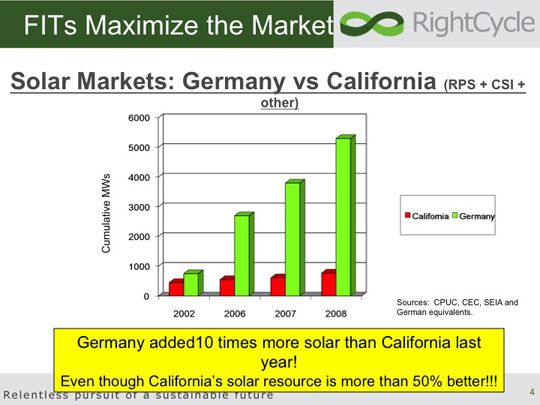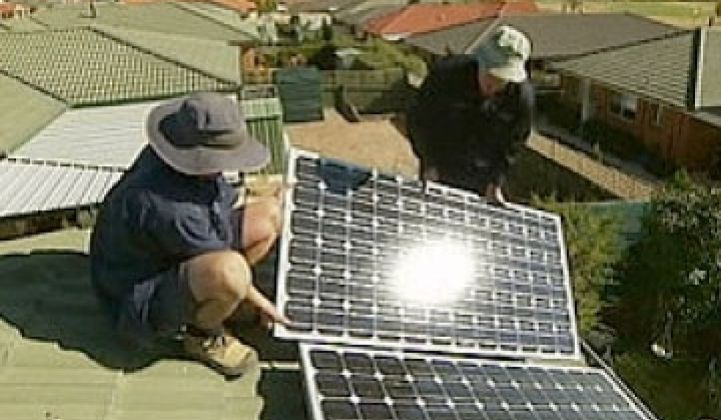The U.S. still doesn't really have an energy policy. Aside from the desire to keep petroleum costs low.
And the U.S. solar market remains thwarted by tight financing, fragmented policies, and spotty permitting, as well as restrictive access to public lands. Arguably, policy trumps technology in matters of energy, and the U.S. has a long way to go in developing a favorable energy and solar policy.
Ted Ko of the FIT Coalition spoke on Wednesday night at the SVPVS at PARC in Palo Alto to advocate for feed-in tariffs as the best policy to get solar into the U.S. market, offering a specific advocacy for Wholesale Distributed Generation.
Ted Ko is Associate Executive Director at the FiT Coalition, serving along with Craig Lewis of RightCycle.
Ko, the FiT Coalition, and Craig Lewis' consultancy, RightCycle, all advocate for WDG (Wholesale Distributed Generation) -- deployments under 20 megawatts with the energy sold to the utility. These WDG deployments are on the distribution grid, not the transmission grid, and as such, don't require transmission build-out.
Ko claims that there is significant locational benefit to WDG, and that this value often doesn't seem to get recognized. Ko claims that distribution-interconnected generation is 35 percent more valuable than transmission-interconnected generation because of low transmission losses and not having to build out the transmission grid.
Ko goes so far as to claim that the "Renewable Portfolio Standard (RPS) in California has failed." He bolsters his argument with this data: California's renewable energy piece was 14 percent of the energy mix in 2003 and actually dropped down to 13 percent in 2008. Further, he asserts that there is little chance that will California achieve its goal of 20 percent in 2010 and 33 percent in 2020.
Ko adds that the RPS has been a failure from a solar standpoint (although the RPS doesn't count rooftop PV), with only a few large PV projects currently up and running in the state. According to the speaker, solar's best bet is "smaller projects that can get us there fast with no transmission lines and can deliver 5 percent ratepayer savings."
The answer, according to Ko, is getting a feed-in tariff imposed in California and in the U.S. Ko defined the feed-in tariff as a predefined, pre-approved PPA between renewable energy generators and utilities. He called it "the most effective policy in the world for getting cost-effective renewable energy online. It's simple, fair and effective."
In California, the 2008 IEPR recommended instituting FiTs. The IEPR is a bi-annual report published by the California Energy Commission.
The FiT Coalition is pushing for REESA, the Renewable Energy and Economic Stimulus Act, to include a feed-in tariff. The Coalition claims that the FiT can make the the 33 percent RPS real, on schedule, and achievable.
According to Ko, "a FiT is the reason that Germany installed fifteen times more solar than California." He also asserts that "Germany is the gold standard for FiTs."
According to Ko, Retail Distributed Generation (RDG) and Net Metering models fail to deliver. Retail DG doesn't count to the RPS and ultimately doesn't amount to much. Even the multi-gigawatt California Solar Initiative (CSI) doesn't make a dent. He asserts that there are a lot of places that just don't work for net metering: multi-tenant buildings, etc.
He claims that FiTs are an easy choice. They reduce parasitic transaction costs (paperwork and permitting time, basically) -- which can add 10 percent on the ratepayer cost for California projects versus German ones. In Germany, the required paperwork amounts to a four-page process, according to Ko.
Here's a list of some FIT or FIT legislation activity in progress:
Municipalities
- Gainesville, FL enacted a German style FiT in early 2009, which is sold out to 2016. This municipality has high rates in the 26 to 32 cent range.
- California's SMUD launched a massive FiT early this year with low rates in the 14 to 15 cent range.
- Discussions for FiTs are in the early stage with Palo Alto, California and several local utilities in Colorado.
States and Provinces
- Vermont enacted the first statewide FiT in mid-2009.
- Ontario, Canada has just enacted a comprehensive FiT.
- REESA and AB1106 are now active in California.
National
- HR6401 (Inslee) will be re-introduced in mid-2010.
Germany is experiencing a bit of a feed-in tariff backlash as their citizenry reacts to FiT dollars going to Chinese, rather than German, solar module manufacturers. FiTs can also be construed as a tax -- and that's political poison in the U.S.
Gary Kremen, solar entrepreneur and founder of Clean Power Finance, had this to say on the subject: "FiTs are great if they are a long-term commitment on the part of government and utilities. Off-and-on FITs make planning and the mandatory required financing hard, if not impossible."

Quick Acronym Review
- DG - Distributed Generation
- RDG - Retail DG behind the meter, net metered
- WDG - Wholesale DG, 20 megawatts and under, connected to the distribution grid not the transmission grid, close to the load but not behind the meter, all energy sold to the utility -- Potential WDG market 100X bigger than RDG market size
- FIT - Feed in Tariff = predefined, pre-approved PPA between RE generators and utilities.
- RPS - Renewable Portfolio Standard



